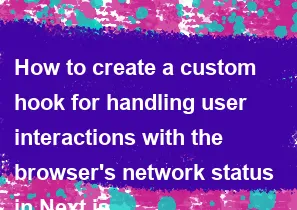How to create a custom hook for handling user interactions with the browser's network status in Next.js

To create a custom hook for handling user interactions with the browser's network status in Next.js, you can use the useEffect hook to listen for online/offline events and update the state accordingly. Here's a basic example:
jsximport { useState, useEffect } from 'react';
const useNetworkStatus = () => {
const [isOnline, setIsOnline] = useState(navigator.onLine);
useEffect(() => {
const handleOnline = () => setIsOnline(true);
const handleOffline = () => setIsOnline(false);
window.addEventListener('online', handleOnline);
window.addEventListener('offline', handleOffline);
return () => {
window.removeEventListener('online', handleOnline);
window.removeEventListener('offline', handleOffline);
};
}, []);
return isOnline;
};
export default useNetworkStatus;
This custom hook, useNetworkStatus, returns a boolean value indicating whether the browser is currently online or offline.
To use this custom hook in your Next.js application, you can import it and call it within your component:
jsximport React from 'react';
import useNetworkStatus from '../hooks/useNetworkStatus';
const MyComponent = () => {
const isOnline = useNetworkStatus();
return (
<div>
<h1>Network Status</h1>
<p>{isOnline ? 'Online' : 'Offline'}</p>
</div>
);
};
export default MyComponent;
This component will render "Online" or "Offline" depending on the current network status.
Remember to create a folder named hooks in your project directory and place the useNetworkStatus hook inside a file, such as useNetworkStatus.js, within that folder. This ensures proper organization of your custom hooks.
-
Popular Post
- How to optimize for Google's About This Result feature for local businesses
- How to implement multi-language support in an Express.js application
- How to handle and optimize for changes in mobile search behavior
- How to handle CORS in a Node.js application
- How to use Vue.js with a UI framework (e.g., Vuetify, Element UI)
- How to configure Laravel Telescope for monitoring and profiling API requests
- How to create a command-line tool using the Commander.js library in Node.js
- How to implement code splitting in a React.js application
- How to use the AWS SDK for Node.js to interact with various AWS services
- How to use the Node.js Stream API for efficient data processing
- How to implement a cookie parser middleware in Node.js
- How to implement WebSockets for real-time communication in React
-
Latest Post
- How to implement a dynamic form with dynamic field styling based on user input in Next.js
- How to create a custom hook for handling user interactions with the browser's device motion in Next.js
- How to create a custom hook for handling user interactions with the browser's battery status in Next.js
- How to implement a dynamic form with dynamic field visibility based on user input in Next.js
- How to implement a dynamic form with real-time collaboration features in Next.js
- How to create a custom hook for handling user interactions with the browser's media devices in Next.js
- How to use the useSWRInfinite hook for paginating data with a custom loading indicator in Next.js
- How to create a custom hook for handling user interactions with the browser's network status in Next.js
- How to create a custom hook for handling user interactions with the browser's location in Next.js
- How to implement a dynamic form with multi-language support in Next.js
- How to create a custom hook for handling user interactions with the browser's ambient light sensor in Next.js
- How to use the useHover hook for creating interactive image zoom effects in Next.js